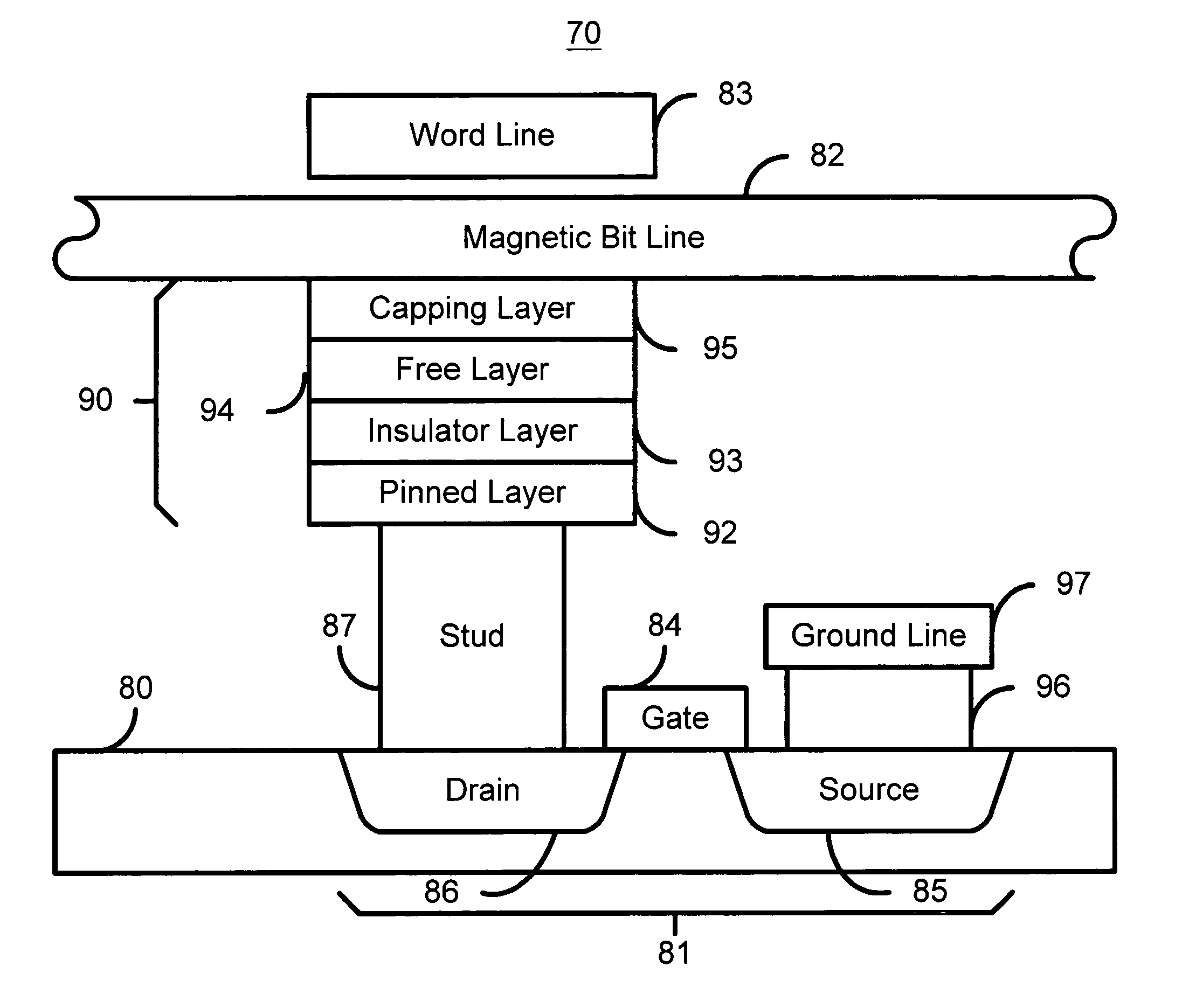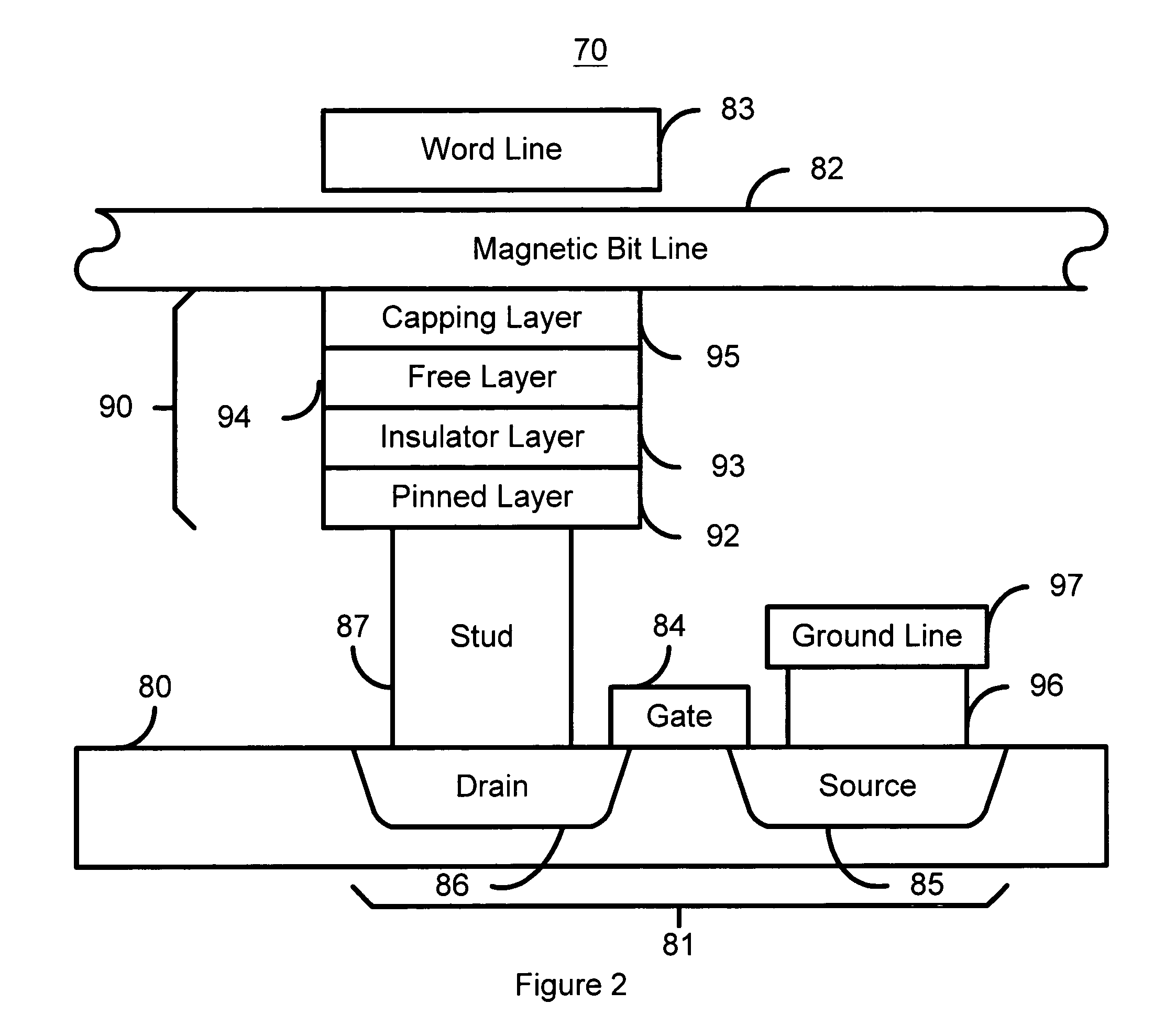Magnetic tunneling junction cell array with shared reference layer for MRAM applications
a cell array and reference layer technology, applied in the field of magnetic memories, can solve the problems of interlayer diffusion, degrade or even damage the exchange coupling, and the annealing step may not be able to activate the exchange effect or set the direction of the exchange coupling, so as to improve reliability, reduce cell size, and simplify manufacturing process
- Summary
- Abstract
- Description
- Claims
- Application Information
AI Technical Summary
Benefits of technology
Problems solved by technology
Method used
Image
Examples
first embodiment
[0035]To more particularly illustrate the method and system in accordance with the present invention, refer now to FIG. 3, depicting a three-dimensional view of a magnetic memory 100 in accordance with the present invention. The magnetic memory 100 is preferably an MRAM 100. The MRAM 100 is shown as including three magnetic memory cells 110, 120, and 130 as well as a reference layer 140. The reference layer 140 also acts as a magnetic write line 140. Thus, the magnetic write lines described in the above-identified co-pending application may be used as the reference layer 140. In addition, other magnetic write lines not inconsistent with the present invention as described herein can also be used as the reference layer 140.
[0036]The reference layer 140 includes magnetic vectors 142, 144, 146, 148, and 150 that preferably rotate no more than approximately ninety degrees from their equilibrium position during writing and return to their equilibrium position when writing is completed. Th...
second embodiment
[0047]FIG. 6A depicts a three-dimensional view of a magnetic memory 300, which is preferably an MRAM 300, in accordance the present invention. The MRAM 300 is similar to the MRAM 100 depicted in FIG. 3. Consequently, analogous components of the MRAM 300 are labeled in a manner that is analogous to the MRAM 100. For example, the magnetic memory cells 310, 320 and 330 of the MRAM 300 correspond to the magnetic memory cells 110, 120, and 130 of the MRAM 100. The MTJ stacks 312, 322 and 332 of the MRAM 300 correspond to the MTJ stacks 112, 122, and 132 of the MRAM 100. The free layers 314, 324 and 334 of the MRAM 300 correspond to the free layers 114, 124, and 134 of the MRAM 100. The tunneling layers 316, 326 and 336 of the MRAM 300 correspond to the tunneling layers 116, 126, and 136 of the MRAM 100. The magnetic vectors 318, 328 and 338 of the MRAM 300 correspond to the magnetic vectors 118, 128, and 138 of the MRAM 100. The reference layer 340 corresponds to the reference layer 140....
third embodiment
[0052]FIG. 7 is a three-dimensional view of a magnetic memory 500 that is preferably an MRAM, in accordance the present invention. The MRAM 500 is similar to the MRAM 300 depicted in FIG. 6A. Consequently, analogous components of the MRAM 500 are labeled in a manner that is analogous to the MRAM 300. For example, the magnetic memory cells 510, 520 and 530 of the MRAM 500 correspond to the magnetic memory cells 310, 320, and 330 of the MRAM 300. The MTJ stacks 512, 522 and 532 of the MRAM 500 correspond to the MTJ stacks 312, 322, and 332 of the MRAM 300. The free layers 514, 524 and 534 of the MRAM 500 correspond to the free layers 314, 324, and 334 of the MRAM 300. The tunneling layers 516, 526 and 536 of the MRAM 500 correspond to the tunneling layers 316, 326, and 336 of the MRAM 300. The magnetic vectors 518, 528 and 538 of the MRAM 500 correspond to the magnetic vectors 318, 328, and 338 of the MRAM 300. The layers 517, 527 and 537 of the MRAM 500 correspond to the layers 317, ...
PUM
 Login to View More
Login to View More Abstract
Description
Claims
Application Information
 Login to View More
Login to View More - R&D
- Intellectual Property
- Life Sciences
- Materials
- Tech Scout
- Unparalleled Data Quality
- Higher Quality Content
- 60% Fewer Hallucinations
Browse by: Latest US Patents, China's latest patents, Technical Efficacy Thesaurus, Application Domain, Technology Topic, Popular Technical Reports.
© 2025 PatSnap. All rights reserved.Legal|Privacy policy|Modern Slavery Act Transparency Statement|Sitemap|About US| Contact US: help@patsnap.com



